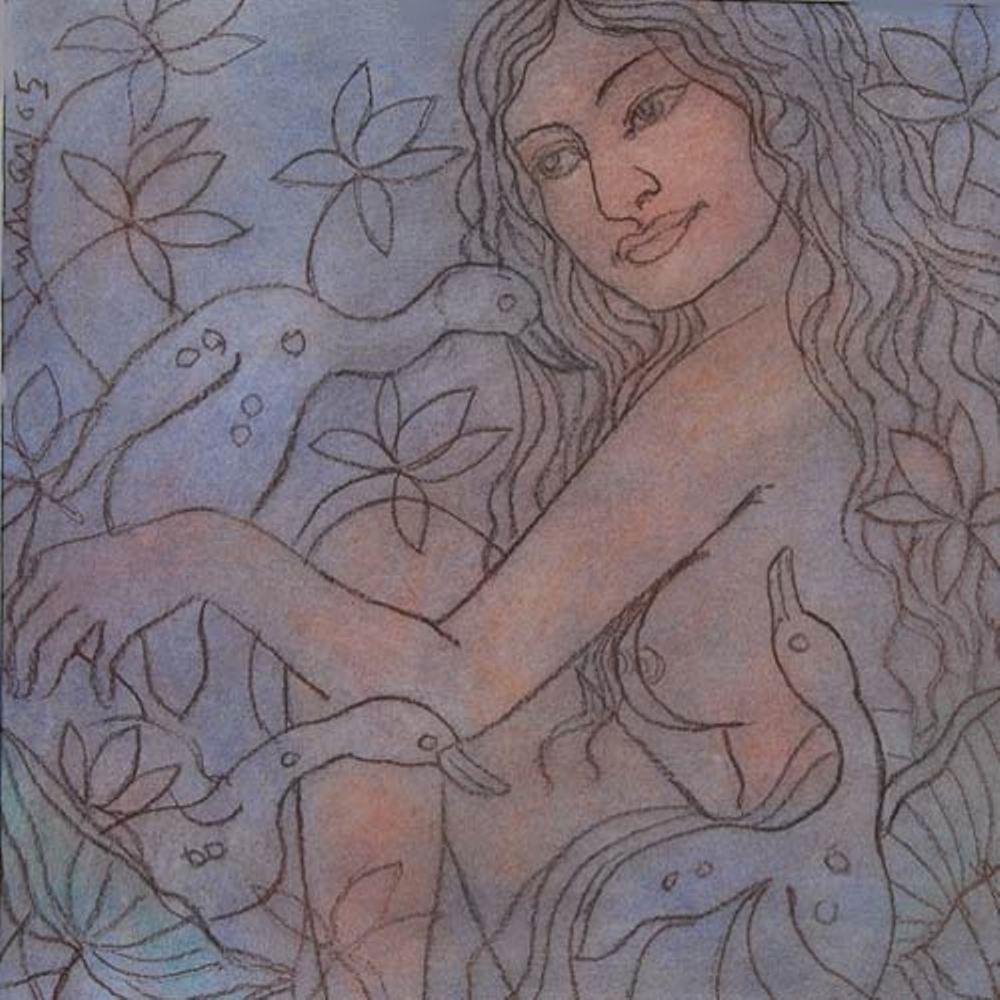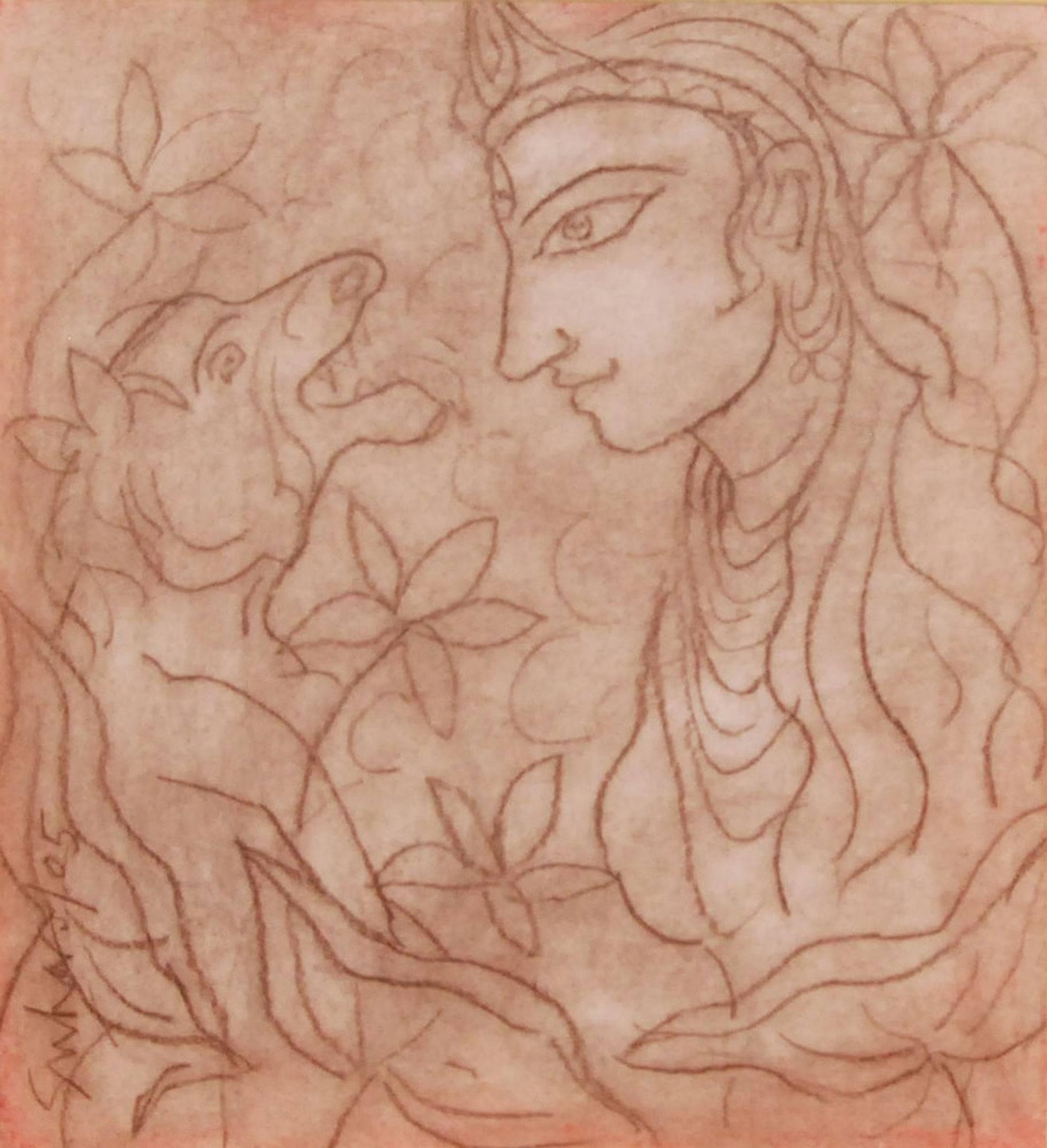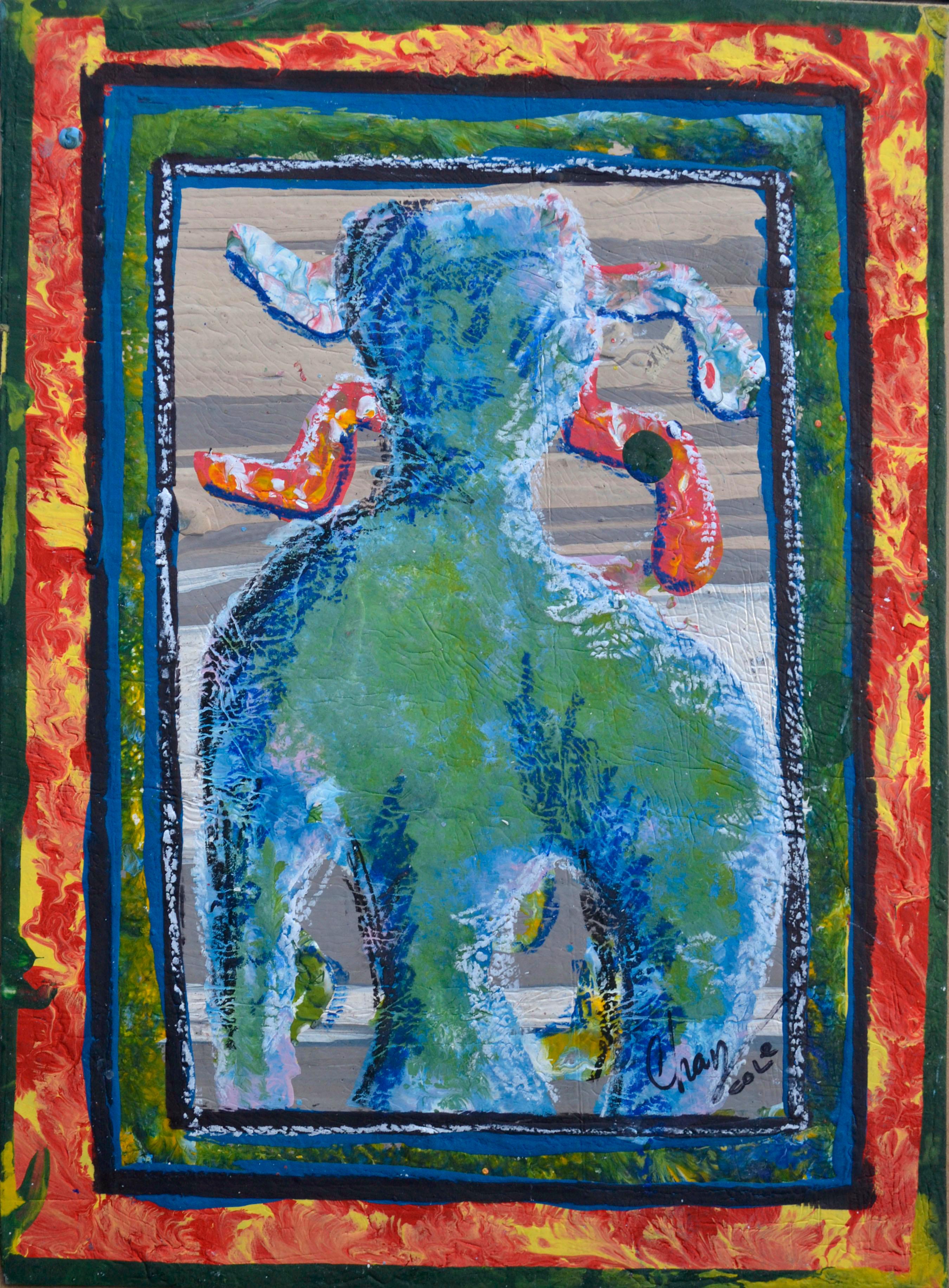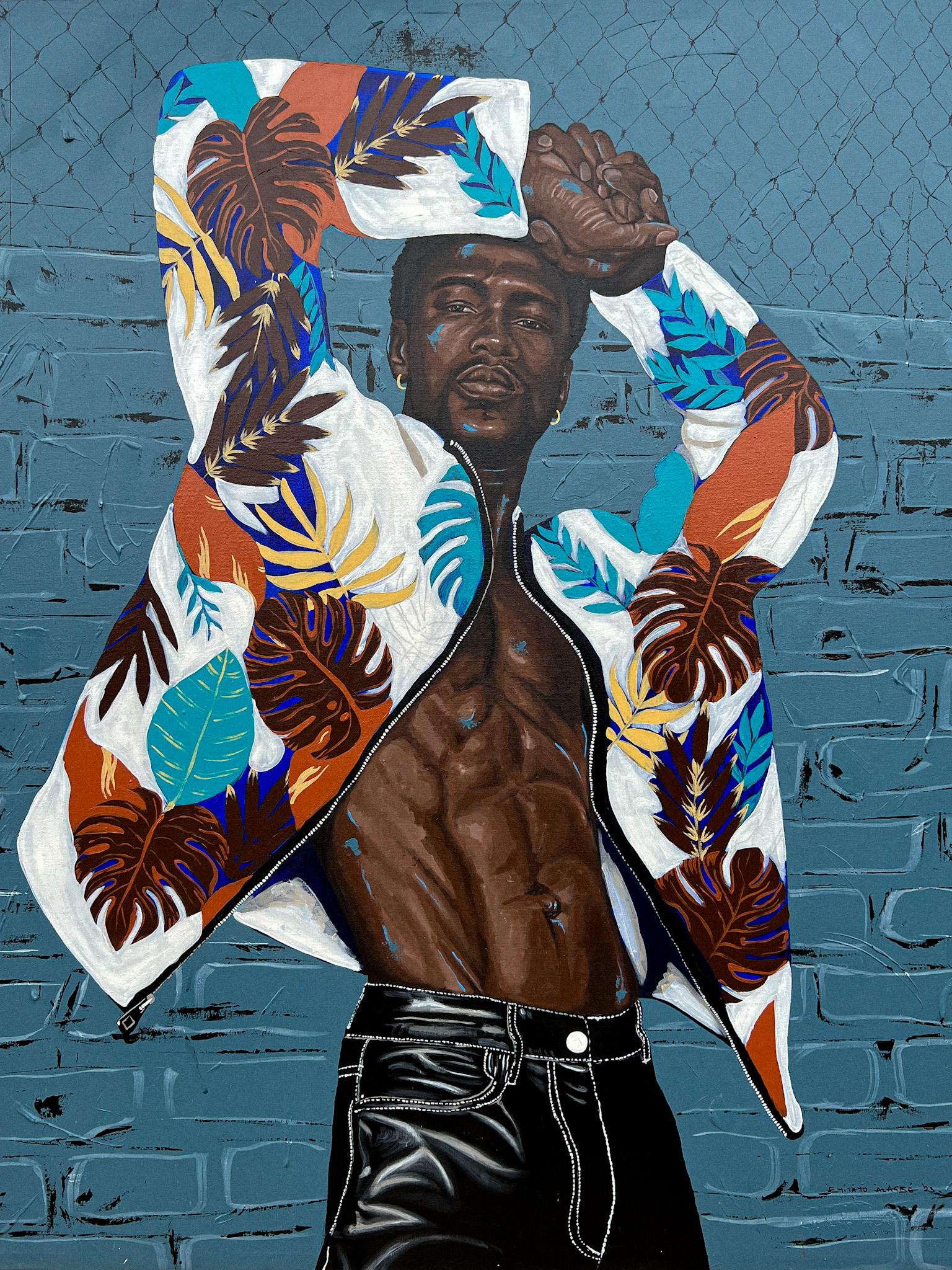Items Similar to Peacocks - Original Mixed Media on Paper by Lucie Navier - 1930s
Want more images or videos?
Request additional images or videos from the seller
Lucie NavierPeacocks - Original Mixed Media on Paper by Lucie Navier - 1930s1930s
1930s
About the Item
Peacocks is a painting realized by Lucie Navier in the 1930s.
Original tempera painting and pastels on cardboard.
Hand-signed by the artist on the lower right corner in red painting "Lucie Navier".
Good conditions.
Mixed composition realized when the artist was very young. The background is realized with a dark pastel and, in the center of the composition there are two figures surrounded by two stylized peacocks.
Lucie Navier (1910-1996). In the 1940s Lucie Navier lived in the region just west of Paris, in the town of Orgerus, Ile-de-France.
The artwork has been relized in the 1920s by the French artist Lucie Navier (1910-1996). In the 1940s Lucie Navier lived in the region just west of Paris, in the town of Orgerus, Ile-de-France.
- Creator:Lucie Navier (1910 - 1996)
- Creation Year:1930s
- Dimensions:Height: 12.6 in (32 cm)Width: 9.85 in (25 cm)Depth: 0.04 in (1 mm)
- Medium:
- Movement & Style:
- Period:
- Framing:Framing Options Available
- Condition:Insurance may be requested by customers as additional service, contact us for more information.
- Gallery Location:Roma, IT
- Reference Number:
About the Seller
4.9
Platinum Seller
These expertly vetted sellers are 1stDibs' most experienced sellers and are rated highest by our customers.
1stDibs seller since 2017
6,771 sales on 1stDibs
Typical response time: 3 hours
- ShippingRetrieving quote...Ships From: Monaco, Monaco
- Return PolicyA return for this item may be initiated within 14 days of delivery.
More From This SellerView All
- Woman's Profile - Original Mixed Media Painting by Alkis Matheos - 20th CenturyBy Alkis MatheosLocated in Roma, ITWoman's Face is an original painting artwork in mixed media on paper realized by the Greek-French artist Alkis Matheos . Very good conditions. Signed by the artist's stamp on the r...Category
20th Century Modern Figurative Paintings
MaterialsPencil, Watercolor, Mixed Media, Pastel
- Roman Countryside - Mixed Media by E. Gioja - 1908By Edoardo GiojaLocated in Roma, ITRoman Countryside is an original modern artwork realized in 1908 by Edoardo Gioja. Mixed media. Hand signed and dated on the lower right margin. Includes frame. Edoardo Gioja (Rome, 1862 - Rome, 1937), an Italian painter and artist. He treated the decoration and portrait with Pre-Raphaelite taste. Influenced by Nino Costa, he repudiated genre painting by reproducing marines, countries, plants, animals and painted and drew with simplicity and with very effective results. He decorated several rooms in London and prepared cartoons for stained glass...Category
Early 1900s Modern Landscape Paintings
MaterialsTempera, Watercolor
- Roman Countryside - Mixed Media by E. Gioja - 1908By Edoardo GiojaLocated in Roma, ITRoman Countryside is an original modern artwork realized in 1908 by Edoardo Gioja. Mixed media. Hand signed and dated on the lower right margin. Includes frame. Edoardo Gioia (Rome, 1862 - Rome, 1937), an Italian painter and artist. He treated the decoration and portrait with Pre-Raphaelite taste. Influenced by Nino Costa, he repudiated genre painting by reproducing marines, countries, plants, animals and painted and drew with simplicity and with very effective results. He decorated several rooms in London and prepared cartoons for stained glass...Category
Early 1900s Modern Landscape Paintings
MaterialsTempera, Watercolor
- The Valley of the Temples - Mixed Colored Tempera on Canvas - Mid-19th CenturyLocated in Roma, ITThe Valley of the Temples is an original modern artwork realized in 19th century. Mixed colored tempera. Include frame. Titled on the lower margin: Veduta del tempio esastilo peri...Category
Mid-19th Century Modern Figurative Paintings
MaterialsTempera
- The Temptation - Painting by Georges Valmier - Early 20th CenturyBy Georges ValmierLocated in Roma, ITThe Temptation is a modern artwork realized by Georges Valmier in the early 20th Century. Mixed colored tempera painting. Hand signed on the lower m...Category
Early 20th Century Modern Figurative Paintings
MaterialsPaper, Tempera
- Mosque in Constantinople - Drawing - Mid-20th CenturyBy Gustavo FrancalanciaLocated in Roma, ITMosque in Constantinople is an original artwork realized in the mid-20th century, and attributed to Gustavo Francalancia. Original mixed colored tempera and watercolor on plywood. ...Category
Mid-20th Century Modern Figurative Paintings
MaterialsTempera, Watercolor
You May Also Like
- Radha, Tempera Coloured Conte on Pastel on Paper by Artist Suhas Roy "In Stock"By Suhas RoyLocated in Kolkata, West BengalSuhas Roy - Radha - 20 x 20 inches ( unframed size) Tempera Coloured Conte on Pastel on Paper , 2005 Suhas Roy 's mystic woman which he calls 'Radha', either Oil on canvas or sof...Category
Early 2000s Modern Figurative Paintings
MaterialsPastel, Board, Paper, Conté, Tempera
- Durga, Indian Goddess, Mythology, Tempera & Pastel on board in Brown "In Stock"By Suhas RoyLocated in Kolkata, West BengalSuhas Roy - Durga - 20 x 20 inches (unframed size) Tempera and Pastel on Board , 2005 ( Framed & Door Delivered ) Durga- Indian goddess combating evil...Category
Early 2000s Modern Figurative Paintings
MaterialsPastel, Tempera, Board
- "Strong Arm" Figurative AbstractLocated in Soquel, CABright figurative abstract with rich layers of texture and color by Chaz Cole (American, 20th Century). Irregular perimeter. Signed and dated "Chaz Cole" lower right. Signed and date...Category
1990s Abstract Expressionist Abstract Paintings
MaterialsPastel, Tempera, Cardboard
- Yoga Feelings On My Vintage JacketLocated in Ibadan, OyoAlagbe's artwork draws attention to the man's jacket, which showcases his bare chest. The jacket, reminiscent of a vintage style, represents the layers we often wear to shield ourselves from the world. By revealing his bare chest, the man symbolizes a willingness to be vulnerable and open to self-exploration. The jacket becomes a canvas for introspection, encouraging viewers to reflect on their own inner journeys toward peace and self-discovery. The quote by Geshe Kelsang Gyatso, "We all wish for world peace, but world peace will never be achieved unless we first establish peace within our own minds," resonates deeply with Alagbe's artwork. It highlights the idea that true peace cannot be attained externally unless we find serenity within ourselves. The artwork invites viewers to examine their own inner landscape and cultivate a sense of harmony, balance, and compassion toward themselves and others. Embedded within the artwork is another profound quote, this time from The Bhagavad Gita...Category
21st Century and Contemporary Modern Figurative Paintings
MaterialsAcrylic, Canvas, Pastel, Ink
- Rare Modernist Hungarian Rabbi Pastel Drawing Gouache Painting Judaica Art DecoBy Hugó ScheiberLocated in Surfside, FLRabbi in the synagogue at prayer wearing tallit and tefillin. Hugó Scheiber (born 29 September 1873 in Budapest – died there 7 March 1950) was a Hungarian modernist painter. Hugo Scheiber was brought from Budapest to Vienna at the age of eight where his father worked as a sign painter for the Prater Theater. At fifteen, he returned with his family to Budapest and began working during the day to help support them and attending painting classes at the School of Design in the evening, where Henrik Papp was one of his teachers. He completed his studies in 1900. His work was at first in a post-Impressionistic style but from 1910 onward showed his increasing interest in German Expressionism and Futurism. This made it of little interest to the conservative Hungarian art establishment. However, in 1915 he met the great Italian avant-gardist Filippo Tommaso Marinetti and the two painters became close friends. Marinetti invited him to join the Futurist Movement. The uniquely modernist style that he developed was, however, closer to German Expressionism than to Futurism and eventually drifted toward an international art deco manner similar to Erté's. In 1919, he and his friend Béla Kádar held an exhibition at the Hevesy Salon in Vienna. It was a great success and at last caused the Budapest Art Museum to acquire some of Scheiber's drawings. Encouraged, Scheiber came back to live in Vienna in 1920. A turning point in Scheiber's career came a year later, when Herwarth Walden, founder of Germany's leading avant-garde periodical, Der Sturm, and of the Sturm Gallery in Berlin, became interested in Scheiber's work. Scheiber moved to Berlin in 1922, and his paintings soon appeared regularly in Walden's magazine and elsewhere. Exhibitions of his work followed in London, Rome, La Paz, and New York. Scheiber's move to Germany coincided with a significant exodus of Hungarian artists to Berlin, including Laszlo Moholy-Nagy and Sandor Bortnyik. There had been a major split in ideology among the Hungarian avant-garde. The Constructivist and leader of the Hungarian avantgarde, Lajos Kassák (painted by Hugó Scheiber in 1930) believed that art should relate to all the needs of contemporary humankind. Thus he refused to compromise the purity of his style to reflect the demands of either the ruling class or socialists and communists. The other camp believed that an artist should be a figurehead for social and political change. The fall out and factions that resulted from this politicisation resulted in most of the Hungarian avant gardists leaving Vienna for Berlin. Hungarian émigrés made up one of the largest minority groups in the German capital and the influx of their painters had a significant effect on Hungarian and international art. Another turning point of Scheiber's career came in 1926, with the New York exhibition of the Société Anonyme, organized by Katherine Dreier. Scheiber and other important avant garde artists from more than twenty-three countries were represented. In 1933, Scheiber was invited by Marinetti to participate in the great meeting of the Futurists held in Rome in late April 1933, Mostra Nazionale d’Arte Futurista where he was received with great enthusiasm. Gradually, the Hungarian artists began to return home, particularly with the rise of Nazism in Germany. Kádar went back from Berlin in about 1932 and Scheiber followed in 1934. He was then at the peak of his powers and had a special flair in depicting café and cabaret life in vivid colors, sturdily abstracted forms and spontaneous brush strokes. Scheiber depicted cosmopolitan modern life using stylized shapes and expressive colors. His preferred subjects were cabaret and street scenes, jazz musicians, flappers, and a series of self-portraits (usually with a cigar). his principal media being gouache and oil. He was a member of the prestigious New Society of Artists (KUT—Képzőművészek Új Társasága)and seems to have weathered Hungary's post–World War II transition to state-communism without difficulty. He continued to be well regarded, eventually even receiving the posthumous honor of having one of his images used for a Russian Soviet postage stamp (see image above). Hugó Scheiber died in Budapest in 1950. Paintings by Hugó Scheiber form part of permanent museum collections in Budapest (Hungarian National Museum), Pecs (Jannus Pannonius Museum), Vienna, New York, Bern and elsewhere. His work has also been shown in many important exhibitions, including: "The Nell Walden Collection," Kunsthaus Zürich (1945) "Collection of the Société Anonyme," Yale University Art Gallery, New Haven, Connecticut (1950) "Hugó Scheiber: A Commemorative Exhibition," Hungarian National Museum, Budapest (1964) "Ungarische Avantgarde," Galleria del Levante, Munich (1971) "Paris-Berlin 1900-1930," Centre Georges Pompidou, Paris (1978) "L’Art en Hongrie, 1905-1920," Musée d’Art et l’Industrie, Saint-Etienne (1980) "Ungarische Avantgarde in der Weimarer Republik," Marburg (1986) "Modernizmus," Eresz & Maklary Gallery, Budapest (2006) "Hugó Scheiber & Béla Kádár," Galerie le Minotaure, Paris and Tel Aviv (2007) Hugó Scheiber's paintings continue to be regularly sold at Sotheby's, Christie's, Gillen's Arts (London), Papillon Gallery (Los Angeles) and other auction houses. He was included in the exhibition The Art Of Modern Hungary 1931 and other exhibitions along with Vilmos Novak Aba, Count Julius Batthyany, Pal Bor, Bela Buky, Denes Csanky, Istvan Csok, Bela Czobel, Peter Di Gabor, Bela Ivanyi Grunwald, Baron Ferenc Hatvany, Lipot Herman, Odon Marffy, C. Pal Molnar...Category
Early 20th Century Modern Figurative Paintings
MaterialsPaper, Charcoal, Pastel, Watercolor, Gouache
- "Nude in Bubble" 1960s Paint & Pastel Nude American Modernist Jack HooperBy Jack HooperLocated in Arp, TXJack Hooper "Nude in Bubble" c. 1960 Gouache and pastel on paper 15"x18" unframed Signed in pencil lower left Jack Hooper's abstract artwork, featuring a figure outlined in bold bla...Category
Mid-20th Century American Modern Mixed Media
MaterialsPaper, Pastel, Gouache





